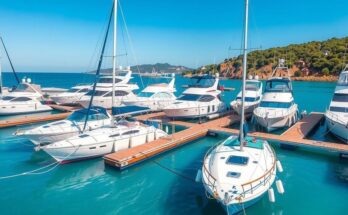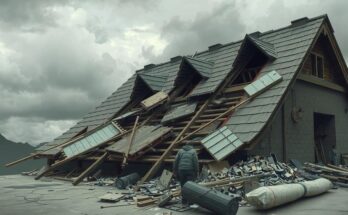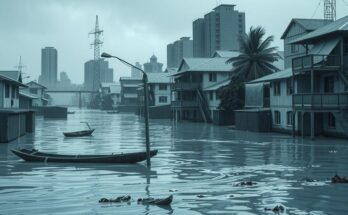On Tuesday, six tropical cyclones were active simultaneously in the southern hemisphere, with three originating in the south-west Pacific. Cyclone Alfred reached category-4 intensity, while Rae caused damage in Fiji. Cyclone Bianca skirted land, and two additional storms, Garance and Honde, developed in the Indian Ocean around Madagascar. This simultaneous occurrence, though uncommon, is a notable meteorological event.
On Tuesday, a rare meteorological phenomenon emerged in the southern hemisphere, where six named tropical cyclones were concurrently active. Notably, three of these cyclones formed in the south-west Pacific, with Severe Tropical Cyclone Alfred developing on February 20 in the Coral Sea, north-east of Australia. This cyclone reached a category-4 hurricane strength with sustained winds of 105 mph and gusts of approximately 140 mph.
Currently, Alfred is moving southward along the Queensland coast, prompting the Australian Bureau of Meteorology to issue warnings for strong winds and rough seas. While it is unlikely to make landfall, the trajectory remains under close observation due to the uncertainty of its proximity to the coast.
In the same region, two additional storms, Rae and Seru, were observed. Tropical Cyclone Rae formed just north of Fiji on February 22 and caused significant damage due to flooding and winds that reached about 100 mph. Cyclone Seru, which originated on February 24 over the Solomon Islands, moved southward while staying offshore, passing east of Vanuatu and New Caledonia.
Severe Tropical Cyclone Bianca was active in the Timor Sea from February 18 to 27, achieving a peak intensity comparable to a category 3 hurricane. It travelled westward before veering south, circumventing land without making contact.
In the south-west Indian Ocean, two more cyclones developed on Monday, bracketed around Madagascar. Intense Tropical Cyclone Garance, equivalent to a category 3 cyclone, formed north-east of Madagascar and is expected to impact the French island of Réunion with gusts reaching 120 mph and the potential for heavy rainfall of up to 600 mm. Additionally, Severe Tropical Storm Honde, equivalent to a category 1 storm, is moving south-east, skirting the southern tip of Madagascar.
While the occurrence of six named storms simultaneously is infrequent, it is not unprecedented for the southern hemisphere. The Pacific held a record for six simultaneous storms once in August 1974, while the Atlantic’s highest count was five storms recorded in September 1971.
In conclusion, the simultaneous occurrence of six tropical cyclones in the southern hemisphere is a remarkable meteorological event, highlighting significant cyclonic activity across various oceanic regions. While Cyclone Alfred poses a potential threat along the Queensland coast, damage has already been reported from Cyclone Rae in Fiji. Ongoing vigilance by meteorological authorities is required to monitor these conditions as they develop further.
Original Source: www.theguardian.com




